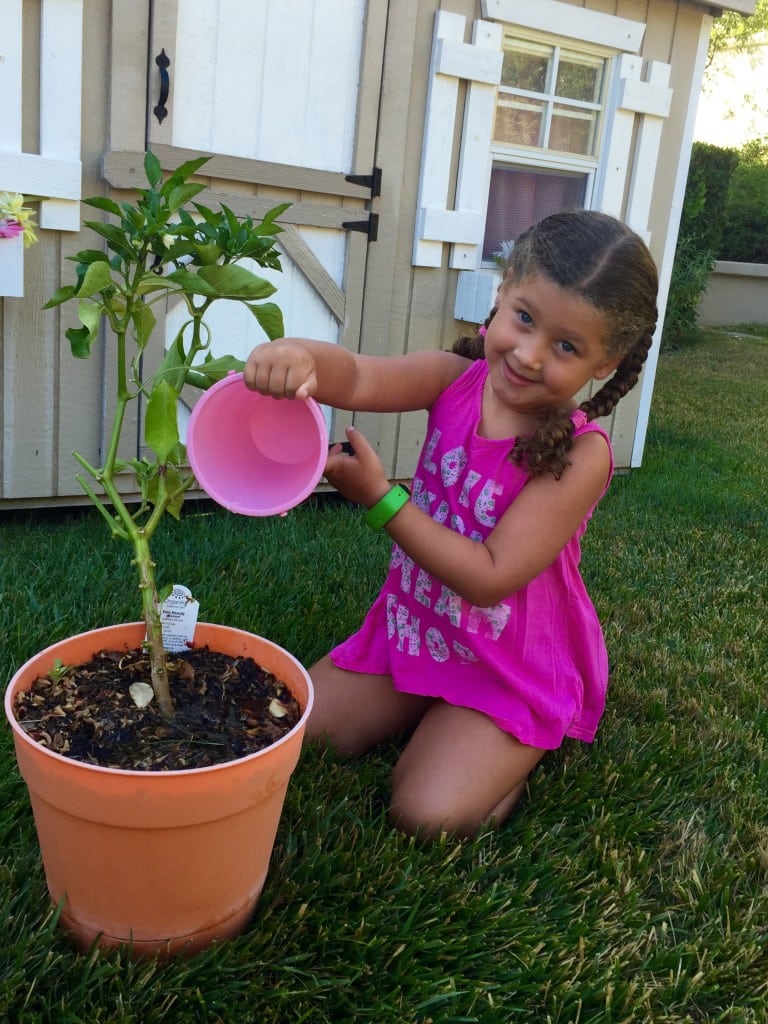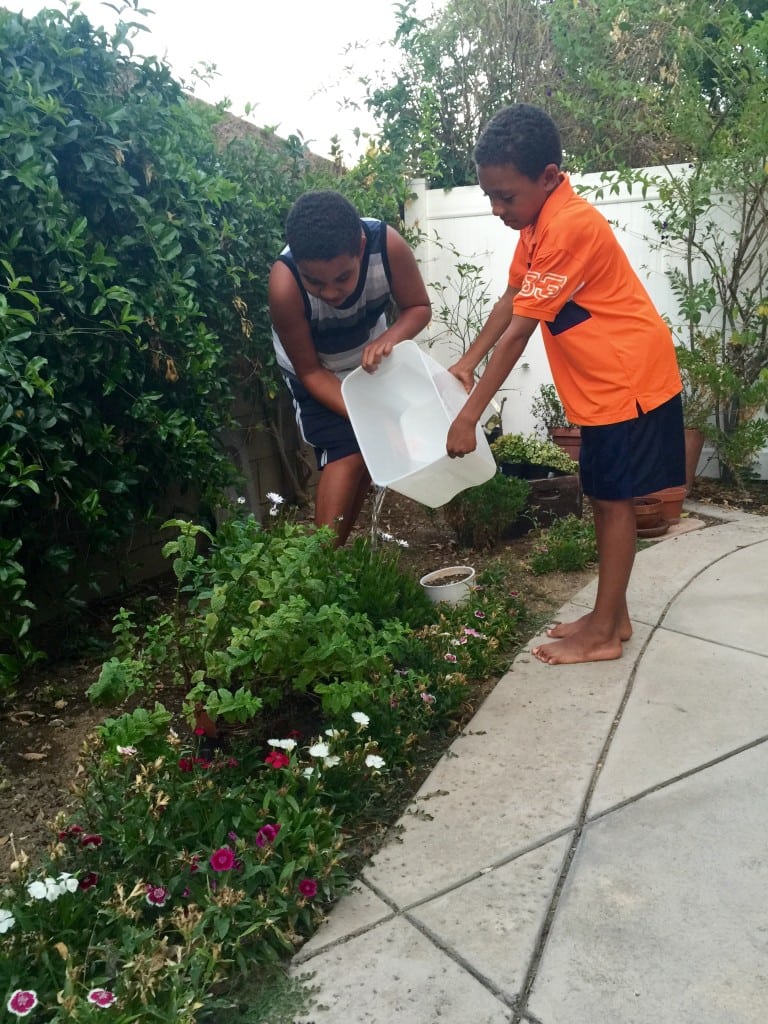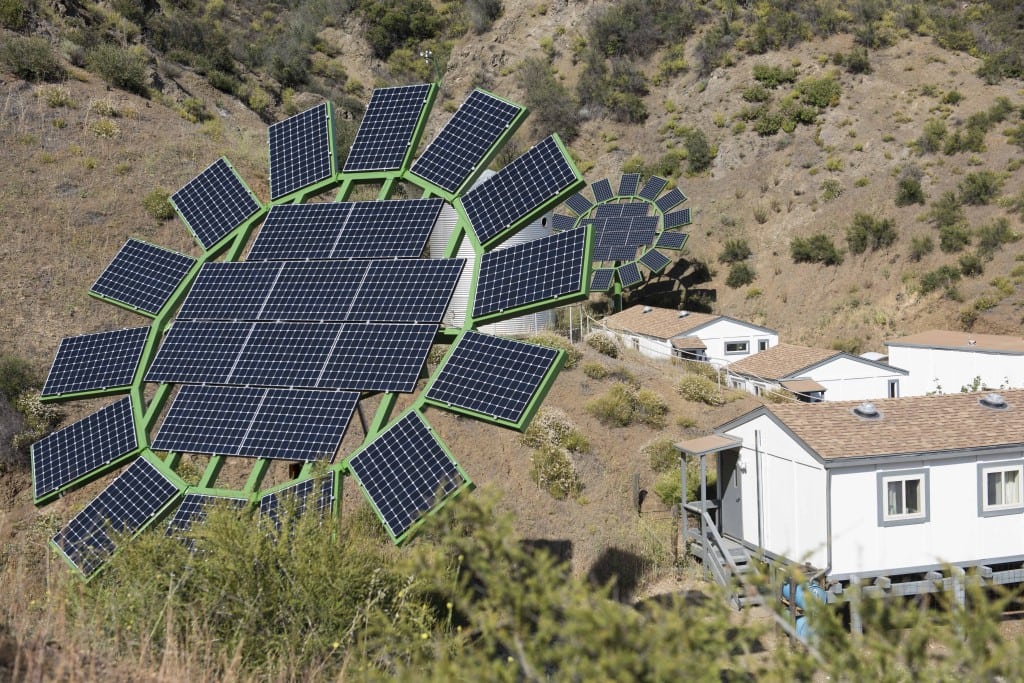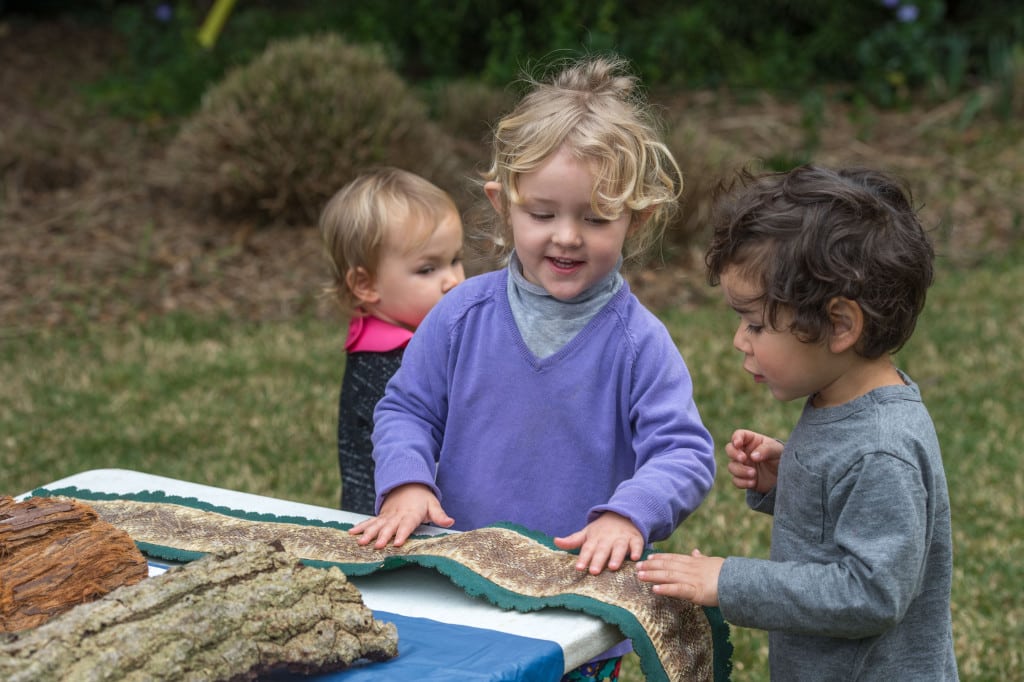
Bettina Bush’s 5-year-old daughter, Cassie, uses her pink bucket to catch warm-up water in the shower, then waters the family garden. PHOTO COURTESY BETTINA BUSH
This past spring, after a disappointingly dry winter made it clear that 2015 would be the fifth year of California’s punishing drought, Bettina Bush’s 5-year-old daughter, Cassie, started learning about hygiene at school. “She was spending a lot of time in the bathroom washing her hands,” says the L.A. mom of two. The water was running, and it was time for some positive parenting and a mother-daughter talk.
Bush, editor-at-large for Working Mother Media and host of the nationally syndicated Working Mother radio show, asked Cassie whether she remembered the last time it rained (she couldn’t), and told her it was important to save water so the flowers in their garden had enough to drink. A discussion of the ways the family uses – and could save – water inspired Cassie to put her pink plastic bucket into her mom’s shower to catch water for the flowers. “She started to make it her idea,” says Bush, who also has a 3 ½-year-old son she calls “the tooth brush police.”
Despite talk of El Niño and a possible wet winter this year, “July, August and September are the months when we tend to use the most water,” says Penny Falcon, water conservation policy manager at the L.A. Dept. of Water and Power (DWP). “Every little drop counts right now.”
Talk and Empower
While it is important for kids to understand that water is a precious resource and the drought makes conservation essential, talking about the drought will be less scary if you give them the chance to help.
“You don’t want to frighten kids,” says Dennis Nelson, president and CEO of the Project WET Foundation, a nonprofit dedicated to providing water education resources for teachers and the community. “Being part of the solution, I think that gives hope.”
Don’t assume your kids haven’t heard about the drought, even if you haven’t talked with them. “Kids are listening, and they will hear things,” says Emi Yoshimura, education programs manager at Descanso Gardens in La Cañada-Flintridge and mother of a 4-year-old and a 5-month-old. Start the conversation and make sure your kids have accurate information – and a plan.
Kerjon Lee, public affairs manager for L.A. County Public Works and father of three, reminds parents that kids are watching as well. “Your actions have a huge impact on the behaviors they adopt,” he says.
Focus On Simple Things

Brandon Lee, 10, at left, and Jordan Lee, 11, use warm-up water collected from the shower to water an herb and flower garden in their Santa Clarita backyard. Their father, Kerjon Lee, is public affairs manager for L.A. County Public Works. PHOTO COURTESY KERJON LEE
There are plenty of simple – and probably familiar to most families at this point – things kids can do to reduce their water use:
- Turning off water while they lather their hands or brush their teeth (saves up to 10 gallons);
- Catching “warm-up” water before they shower (saves a gallon or two);
- Shortening showers to five minutes or filling the bathtub a little less (saves 12 gallons per shower or bath).
Kids who help around the house can also conserve by:
- Making sure the dishwasher and washing machine only run when there is a full load (saves 12 and 50 gallons respectively);
- Sweeping, rather than hosing off, sidewalks and driveways (saves 80 gallons); and
- Watering the yard only in the morning or evening (saves up to 100 gallons per watering).
“They can contribute,” says Nelson. “That may seem like a very, very small amount of water going down the drain. But multiply it by 500,000 kids and that’s a lot of water.”
Make a Natural Water Connection
To really help kids understand the importance of conservation, head outdoors.
Falcon says parents should explain that the water we use in Los Angeles travels hundreds of miles from the Colorado River to get to our taps. “I think that’s important for Los Angeles kids to understand,” says the mom of a 10-year-old and an 8-year-old who admits to driving around in a dirty car. “It’s not like we have a big lake in our back yard.”
Speaking of your back yard, that is a great place to teach kids about water. Yoshimura says watering a plant “really helps kids feel a connection and see how important water is.”
Venture farther afield and take advantage of kids’ fascination with wildlife to talk about how the animals, birds and insects around us depend on water, says Rachel Young, Descanso Gardens’ director of horticulture. Or take older kids to volunteer at a Heal the Bay or a Friends of the L.A. River clean-up. “Part of the story is about pollution and waste water, and where the rain goes,” Young says. “I think volunteering is a great way to get kids involved with water conservation.”
Think Outside the Drop

Sunflower-shaped solar panels at The MUSE School’s primary campus in Calabasas will generate between 70 and 90 percent of the school’s electricity, saving water as well. PHOTO COURTESY THE MUSE SCHOOL
At The MUSE School’s two Calabasas campuses, students and staff focus on minimizing waste of food, energy and water, and conservation is part of the fabric of every school day. And sometimes water savings comes in ways most people don’t consider.
In the fall, the school will convert to a completely plant-based meal program, and each student and staff member will save 80,000 gallons of water per year through the meals they eat on campus. Meat and dairy products take lots of water to produce, so eating less of those products is a great way to conserve. “It is one of the biggest and easiest things you can do,” says Head of School Jeff King.
The campuses have electric vehicles that staff members can use to carpool, saving gasoline and the water it takes to refine it. And in the fall, the school’s buses will transport students for free, saving parents from driving students and encouraging further gasoline and water conservation.
MUSE also recently installed solar panels to generate 90 percent of the electricity needed at its primary campus. And a dashboard feature will let students see how much electricity is produced, and track the savings of water, coal and other resources. “Our students are highly engaged in this. It’s completely a part of the day-to-day,” King says.
Sharon Masters-Oliver, who teaches second grade at Bedford Charter for Enriched Studies in Northridge, says she talks with her students about the simple water-saving steps they can take at home, but also encourages them to save water at school. She asks her students to bring reusable water bottles to drink from, for instance. “We talk about how recycling uses water, too. And manufacturing uses water in most processes,” she says.
Masters-Oliver is always on the lookout for fun “craftivities” that will help her conservation messages stick, and has a few recommendations for parents:
- Help your children make their own book with tips for conserving water.
- Make a family chart and record everyone’s water savings.
- Make a colorful mobile with water-saving tips listed on paper rain drops.
Masters-Oliver says she knew her strategies were working when students who found half-full water bottles on the playground brought them back to the classroom to use in watering the plants. “We don’t want to waste that,” she says they told her. “I’m seeing little steps.”
Remember That Drought is Normal

At Descanso Gardens, educators use kids’ fascination with plants and wildlife to prompt discussions about water conservation. PHOTO BY MARTHA BENEDICT
Yes, this drought period will eventually end, but families who stay in sunny Southern California will still need to keep their water-saving habits intact. “It’s a great environment to be in, but our Mediterranean climate makes water conservation a way of life,” says Lee, an L.A. native whose sons collect shower warm-up water and use egg timers to keep showers short.
Your family can learn more about our native climate and habitats at places such as the native gardens at Descanso Gardens, or other natural areas. There, the kids can see that there are many plants, animals and insects living and growing with very little water. “It is a drought, but this is natural,” explains Descanso’s Young. “It’s part of what happens in California. It is good for kids to learn that it is OK for us to have drought years as long as we take care of our resources.”
Be Ready For the Rain
Yes, El Niño could bring rain this winter, but experts say our approach to water still has to change. Lee explains that as the planet warms, many experts are predicting that precipitation in California will shift away from snow and toward more rain. So instead of the Sierra snow pack capturing snow and releasing it as water in the spring, we will need to capture rain water as it falls and put it to use here.
Rain barrels stop water that hits your roof from flowing into the storm drains, where it goes straight to the ocean (often mixed with trash and pollutants along the way), and collects it where you can use it. You can find classes and barrels for purchase (often at a discount) through your local water agency.
But don’t just capture the rain, get out there and watch it. “So many Southern Californians never go outside when it rains,” says Young, but kids love to play in the rain.
“We do a lot of appreciating the rain and cheering when it rains,” says Yoshimura, adding that she and her children put out small plastic cups to catch rain, and watch where it goes as it hits the ground – either soaking into the soil or running off toward the street.
But while we all wait for the rain, your kids can take action to save the water we have now. “We need to tell them how they can help,” says Falcon. “Kids like to solve problems.”
Christina Elston is Editor of L.A. Parent.






































